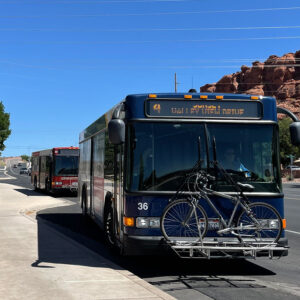
Throughout the world, people want the same things: access to clean air and water; economic opportunities; a safe and healthy place to raise their kids; shelter; lifelong learning; a sense of community; and the ability to have a say in the decisions that affect their lives.
–Institute for Sustainable Communities
Livable Communities
 What does Smart Growth mean? Imagine neighborhoods where family-friendly streets go through to the next intersection rather than dead-ending in unnecessary cul-de-sacs. Where you can easily and safely walk around the corner to your back yard neighbor’s front door or up the street to the local market, barbershop, beauty salon, hardware store, medical clinic, park, school, or branch library. Imagine an entire town or city made up of these neighborhoods.
What does Smart Growth mean? Imagine neighborhoods where family-friendly streets go through to the next intersection rather than dead-ending in unnecessary cul-de-sacs. Where you can easily and safely walk around the corner to your back yard neighbor’s front door or up the street to the local market, barbershop, beauty salon, hardware store, medical clinic, park, school, or branch library. Imagine an entire town or city made up of these neighborhoods.
It is possible. Well-intentioned public officials, developers and redevelopers are often hindered by outdated zoning codes and approval processes. Projects that are reviewed and approved in isolation from surrounding land uses and street layouts can lead to incompatible uses, dead-end or busy streets, and angry neighbors. Innovative, mixed-use developments with streets where pedestrians have priority over vehicles may be delayed or lost if the developer does not have the time or money to go through lengthy rezoning approvals.

Zoning codes and street standards are the very DNA of what makes — or breaks — a place
Vehicle-centered sprawl is not inevitable. It happens by default and by design. Outcomes would be different if people were at the center of land use planning and had options for transportation.
Prescriptive, single-use zoning can be replaced by flexible zoning that allows a variety of compatible uses in a neighborhood, but we don’t have to wait for that to happen. The Congress for New Urbanism teamed up with AARP to craft an incremental way forward. Enabling Better Places: A Handbook for Improved Neighborhoods provides options for communities to consider as they identify and select small-scale, incremental policy changes that can be made without overhauling entire zoning codes and land use policies.
Incremental code changes can benefit a community by …
IMPROVING …
- Conditions for businesses to open, expand or adapt
- The availability of housing options, such as duplexes, garden apartments and accessory dwelling units
- Street design for more pedestrian- and cyclist friendly conditions
ELIMINATING …
- Barriers to creating different types of housing and businesses within neighborhoods
- Underused parking lots — and parking rules that don’t add value to the community
- Mandates for street dimensions and conventions that endanger or impede pedestrians
Putting people first in land use and transportation planning is possible with the right tools and a commitment to making our neighborhoods, towns, cities, and counties livable for people of all ages and abilities. Help us get started.

